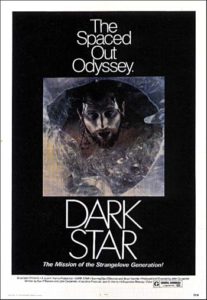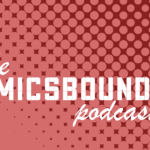
 Dark Star is an ancestor to Alien. An earlier, unrefined rough draft of the iconic film that would leave a permanent mark on science-fiction in as little as five years time. It’s a movie that survives in the public consciousness by means of its association with the historic creation of a perfect film, though it is not by itself without merit. Like many early films from great filmmakers, Dark Star shows the growing pains of a young writer and director still struggling with tone and appropriate cinematic structure, but it still holds the spark of marvellous ideas. There’s an interesting comparison to be made between this film and the franchise screenwriter Dan O’Bannon would go on to create. Some even say Alien represented a “do over” for Dark Star, a second attempt at capturing the idea that had evaded him in this dark space comedy. It’s always intrigued me. Though it vexes some viewers, I still believe there’s a lot to be said about a movie that feels like the crew of the Nostromo woke up mid-cruise and stared out into the void for too long.
Dark Star is an ancestor to Alien. An earlier, unrefined rough draft of the iconic film that would leave a permanent mark on science-fiction in as little as five years time. It’s a movie that survives in the public consciousness by means of its association with the historic creation of a perfect film, though it is not by itself without merit. Like many early films from great filmmakers, Dark Star shows the growing pains of a young writer and director still struggling with tone and appropriate cinematic structure, but it still holds the spark of marvellous ideas. There’s an interesting comparison to be made between this film and the franchise screenwriter Dan O’Bannon would go on to create. Some even say Alien represented a “do over” for Dark Star, a second attempt at capturing the idea that had evaded him in this dark space comedy. It’s always intrigued me. Though it vexes some viewers, I still believe there’s a lot to be said about a movie that feels like the crew of the Nostromo woke up mid-cruise and stared out into the void for too long.
Obviously one of the biggest differences between Dark Star and Alien is that this film is directed by a young John Carpenter instead of Ridley Scott. The differences between these two directors isn’t subtle, and Carpenter’s vision for a future populated by dead-headed, short tempered layabouts is even more nihilistic a dystopia than Scott’s ultra-capitalist future his worldbuilding in both Alien and Blade Runner helped contextualize. The characters in this film, Doolittle, Boiler, Talbot, and Pinback, all clearly hate each other. Or to put it more precisely, they are sick of the sight of one another, and would kill for the cryosleep that Ripley and her fellows would get to experience in the rewrite. Carpenter would already be thinking about his trademark themes of semi-apocalyptic futures. Carpenter also scored the film himself in ominous synthetic glory, though that too is still an unrefined effort, limited by the technology available at the time. In this film, most clearly in the direction, it’s clear that Carpenter is experimenting. You see the masterful eye that would become more adept as time went on, but for now there’s also an experience of “Hey, let’s try this!” that’s witnessable in the film, and the enthusiasm is endearing.
Probably the biggest giveaway to the youth and inexperience of the filmmakers is the movie’s ultra-low budget. It’s essentially proof of concept film, made while the creators were still in film school and cutting any corners they could take to pull of a semi-realistic sci-fi aesthetic. Taken in context, Dark Star absolutely feels like a movie made by friends in somebody’s garage. The astronauts wear children’s toy helmets. Control panels are ice cube trays and one of the crew members literally wears a muffin tin on the front of his costume. And then there’s the alien. A long way off from Alien’s Xenomorph, this creature is literally an unconvincingly spray painted beach ball with feet. It’s not a villain as much as it is a comic-foil, leading Pinback through a cartoon-style chase sequence that’s about as terrifying as Baby’s Day Out. Smartly, the comedy tone of the film allows this to run its course naturally. It’s not out of sync with any of the films other scenes and is actually one of the most memorable sequences of the film, second only to the finale. Still, you can imagine how, as a screenwriter, the other side of what that alien encounter could have been stayed in O’Bannon’s mind and influenced the completely different approach he would go on to take in Alien.

Staunchly in common with Alien is Dark Star’s influence from the realms of classic science fiction and philosophy which gives both films a heady intellectualism, with jokes about phenomenology that all first year philosophy majors will enjoy. Dark Star includes direct references to the works of Ray Bradbury and Philip K. Dick, beginning a trend of the franchise to explore hard sci-fi themes. Isaac Asimov’s writing clearly becomes a direct influence for Alien’s synthetics. Bishop even describes his programming in Alien in alignment with Asimov’s three laws. It’s also, in a way, a rejection of the broad, sweeping space opera that would become wildly popular in a few years with Star Wars. The characters are essentially blue collar workers in a Death Star, literally blowing up planets by means of a set of switches. The job is done for maintenance, not intimidation or conquest, and it’s reinforced throughout that this is a boring job. If Star Wars was the movie that brought sci-fi to the masses, Alien reminded it to grow up. Dark Star bridged that gap and .. oh, wait. The fact that Star Wars wouldn’t come out until in 1977? Only goes to show how ahead of its time Dark Star was.
Of course, Dark Star is also unabashedly a comedy. Its homages to classic sci-fi are essentially satire, with nontraditional protagonists leading trope-laden scenes away from where they would traditionally go. There’s laugh out loud moments within this film, mainly from Pinback’s eccentric behaviour and the absurdist, nonsensical dialogues that crew get into the sound exactly like the sort of conversations you’d have if you’d been overworked, underfed, cramped up in a tiny ship for years and forced to spend time with three other people you despised. These are elements that would be completely absent in Alien, with Scott and the newly added screenwriters choosing to take the direction of the film in a more serious and horror-focussed direction. It’s a thread classic BBC series Red Dwarf would pick up again in 1988, with the story of another set of blue-collar space farers who get to spend their journey together essentially on the basis that they get on each others nerves. While its creators credit Alien with many of the shows early aesthetics, it’s Dark Star to which it owes much of its comedy roots.
In many ways, it’s simply the early seventies school of filmmaking that Dark Star belongs to that means it doesn’t play well to modern audiences. The heady, drug filled days of 1974 feel decades removed from what Ridley Scott delivered us in 1979 and the dark comedy overtones throw off someone placing the film right at the beginning of their Aliens rewatch today. When you watch Dark Star… well, if you watch Dark Star, remember it as the work of a couple of kids in film school on their way to be legends. The biggest strengths of the film: its blue collar spacemen, the lived in aesthetic, the confrontation with technology and fear of that which is “alien”, ended up being the basis of everything that made Alien great five years later. It might be a little rough around the edges, it may be grimy and dirty and covered in some sort of sticky substance you can’t quite identify, but without it, there wouldn’t be anything to write about on 4.26 today.



![[EDITORIAL] WHY ‘JOKER’ IS THE MOST IMPORTANT MOVIE THIS YEAR](https://geekd-out.com/wp-content/uploads/2019/10/67365014_2270210746433212_1471764165671518208_n-150x150.jpg)